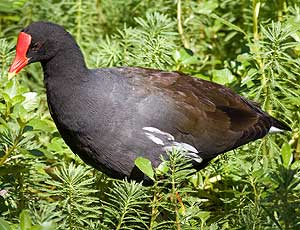The Hawaiian Moorhen is a dark gray bird with a black head and neck, and white feathers on their flanks and on their undertail coverts (or feathers). They have a very distinctive red frontal shield, and their bill tip is yellow with a red base. Their legs and feet are greenish and without lobes. The `Alae `ula usually measure about 13 inches (33 centimeters) in length. Both sexes are similar and have chicken-like cackles and croaks.
Habitat & Behavior:
The Hawaiian Moorhen is known as the most secretive native waterbird. In Hawaiian legend, these birds were thought to have brought fire from the gods to the Hawaiian people. These secretive birds can be found in freshwater marshes, taro patches, irrigation ditches, reservoirs, and wet pastures. They favor dense emergent vegetation near open water, floating or barely emergent mats of vegetation, and water depths of less than 3 feet (1 meter).These birds nest year-round but the active season is usually from March through August. It is believed that the timing of nesting is related to water levels and vegetation growth. The Hawaiian Moorhen usually lays an average of 5 to 6 eggs and incubation is about 22 days. The ‘alae ‘ula eats mollusks, insects, water plants, and grasses. They are good swimmers and chicks can swim shortly after hatching.
Past & Present:
No historical population estimates are available for the endemic Hawaiian Moorhen. Because they are such secretive birds, it is difficult to conduct surveys of this species. It is believed that they were common on the main Hawaiian islands in the 1800s but radically declined by the mid 1900s. Surveys in the 1950s and 1960s estimated no more than 57 individuals. However, the spread of aquaculture in the 1970s and 1980s helped boost their numbers by providing more suitable habitat for these birds.Today, these moorhens can be found only on O`ahu, Kaua`i, and possibly on Maui and Moloka`i. The Kaua`i population is found in lowland wetlands and valleys. A sizable population is found at the Hanalei National Wildlife Refuge. The O`ahu population is widely spread but is mostly found between Haleiwa and Waimanalo. Six marked `Alae `ula were released on Moloka`i in 1983 but they have not been seen since 1985.
The primary cause of decline to this Hawaiian native waterbirds has been loss of wetland habitat. Other factors include introduced predators, alien plants, introduced fish, disease, hybridization, and environmental contaminants.
Conservation Efforts:
State and Federal efforts in protecting wetlands, enforcing strict hunting laws, educating, and working with private organizations and landowners play an important role in ensuring the livelihood of the Hawaiian Moorhen and many other waterbirds. Private organizations such as the World Wildlife Fund and Ducks Unlimited have been actively supporting wetlands conservation.The Hawaiian Moorhen was listed as an endangered species in 1967 under the Federal Endangered Species Act. The U.S. Fish and Wildlife Service is finalizing the Revised Hawaiian Waterbirds Recovery Plan.
